|
|
|
Sort Order |
|
|
|
Items / Page
|
|
|
|
|
|
|
| Srl | Item |
| 1 |
ID:
092120
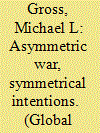

|
|
|
|
|
| Publication |
2009.
|
| Summary/Abstract |
During asymmetric war, a state actor often faces charges of disproportionate harm while the weaker, nonstate side must defend itself against charges of terrorism. Because the state actor faces an adversary embedded among civilians, and the nonstate actor confronts an opponent whose military targets are often so well protected that only its nonmilitary targets are vulnerable, it is difficult for either side to fight without harming civilians. While humanitarian law tries to protect noncombatants to the greatest extent possible, too strict an interpretation of terrorism and proportionality may unduly restrict either side's ability to pursue political claims by force of arms. To successfully walk the line between protecting civilians during asymmetric war and allowing each side a 'fighting chance', it is necessary to take another look at the idea of intentionality and the definition of combatants. While intentional harm is the hallmark of terrorism, state armies also bring intentional harm if they expect to glean military benefits from causing collateral damage to civilians. A tighter understanding of intentionality can further protect innocent, noncombatant civilians. At the same time, however, the international community must recognise that not all civilians are noncombatants. Many civilians take a direct or indirect role in the fighting. As such, some civilians are vulnerable to lethal harm while others remain subject to nonlethal harm. Asymmetric war expands the range of permissible civilian targets that each side may attack without incurring charges of terrorism or disproportionate harm.
|
|
|
|
|
|
|
|
|
|
|
|
|
|
|
|
| 2 |
ID:
098232
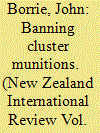

|
|
|
| 3 |
ID:
147529
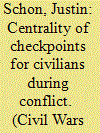

|
|
|
|
|
| Summary/Abstract |
Analyses of the violence–displacement relationship motivate a disaggregation of violence into violence in residential areas (home violence) and violence along migration routes (road violence). These two forms of violence have opposite effects upon displacement, with home violence increasing displacement and road violence decreasing displacement. Yet, conflict scholarship would benefit from additional consideration of the specific activities that constitute road violence. This consideration reveals that road violence primarily involves displacement-deterring violence at checkpoints. This motivates the question: How does checkpoint violence deter displacement? Using interviews with Syrian and Somali refugees, as well as daily data on violence and displacement in Somalia, this paper argues that state and non-state armed groups create and foster uncertainty at checkpoints. Then, they use dramatic violence that is tangible to civilians through their ability to physically see, hear, and smell evidence of it as propaganda. As propaganda, the deterrent effect of checkpoint violence is amplified beyond isolated violent events. More broadly, results from quantitative analysis of the daily data on violence and displacement in Somalia indicate that uncertainty about road violence (road uncertainty) and uncertainty about home violence (home uncertainty) amplify the effects of road violence and home violence, respectively.
|
|
|
|
|
|
|
|
|
|
|
|
|
|
|
|
| 4 |
ID:
109950


|
|
|
|
|
| Publication |
2012.
|
| Summary/Abstract |
The authors investigate a gap in attitudes toward homosexuals in the U.S. military among a select group of people-American civilian undergraduates, Reserve Officer Training Corp (ROTC) cadets, and cadets at military academies. Using a subsample (N = 3057) of data from the Biannual Attitude Survey of Students (BASS), being a military academy cadet is associated with the strongest agreement for barring homosexuals from serving in the military, followed by ROTC cadets and civilians. These trends continue when controlling for respondents' sex and political affiliation-the two most significant predictors of agreeing to bar homosexuals from military service. A small reduction in agreement for barring was found among academy cadets over time.
|
|
|
|
|
|
|
|
|
|
|
|
|
|
|
|
| 5 |
ID:
170012
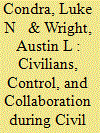

|
|
|
|
|
| Summary/Abstract |
What affects civilian collaboration with armed actors during civil war? While theory and evidence confirm that harm by armed actors influences when and with whom civilians collaborate, we argue that collaboration is also a function of civilians’ perceptions of armed actors’ efforts to minimize collateral casualties. We test this argument using a series of nationwide surveys of Afghan civilians conducted quarterly between 2013 and 2015. Our data record civilian willingness to report roadside bombs to government authorities and perceptions of government and Taliban efforts to minimize civilian harm. Civilians are less (more) willing to collaborate with the government when they perceive the government (Taliban) carelessly using force, even after accounting for political sentiment, local security conditions, and a range of additional confounding factors. Moreover, our evidence suggests that perceived carelessness in the rival’s area of control influences collaboration. We discuss how these empirical results inform broader literatures on collaboration, conquest, occupation, and control.
|
|
|
|
|
|
|
|
|
|
|
|
|
|
|
|
| 6 |
ID:
108847


|
|
|
| 7 |
ID:
191892
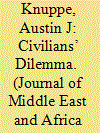

|
|
|
|
|
| Summary/Abstract |
How did Iraq’s ethnic and religious minorities survive the Islamic State (ad-Dawlah al-Islāmiyah, IS) occupation of Ninewa Governorate? Existing accounts of wartime survival either essentialize social identity or ignore it altogether by reducing survival to cost-benefit calculations or political opportunism. Against the conventional wisdom, this article argues that individuals survive conflict by drawing on repertoires – consisting of practices, tools, organized routines, symbols, and rhetorical strategies – to navigate violent situations. Distinct from deliberate calculations or rational strategies, repertoires are creative, flexible, and often contradictory. The author examines Iraqis’ reliance on survival repertoires through a mixed-methods research design of observational data and fieldwork. This study begins by analyzing migration patterns recorded in the United Nation’s Displacement Tracking Matrix. To understand how Iraqis who remained survived the conflict, this work draws on original interviews with Iraqi peacebuilders from minority communities. While most minorities fled during the IS offensive of June 2014, those who remained pursued various forms of cooperation, contention, and neutrality. This research finds that those who remained survived the conflict by mobilizing self-defense groups and by their coordination with members of the anti-IS coalition. Opportunistic collaboration with IS insurgents during the initial stages of the occupation was less common. In areas where the Iraqi Security Forces (al-Quwāt al-Maslahah al-ʿIrāqiyya, ISF) or Peshmerga were absent, residents mobilized community militias unaligned from Baghdād or Arbīl. The findings of this research provide insights for scholars and practitioners interested in peacebuilding, transitional justice, and post-conflict reconstruction in fragile states.
|
|
|
|
|
|
|
|
|
|
|
|
|
|
|
|
| 8 |
ID:
090360
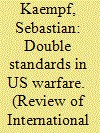

|
|
|
|
|
| Publication |
2009.
|
| Summary/Abstract |
This article investigates how - by breaking with the historical double standards regarding civilian protection in conflicts - by the end of the twentieth century, US warfare has come to comply with International Humanitarian Law (IHL). Yet, civilians are still being killed. This has sparked controversies over what constitutes legitimate targeting practices and as to whether higher levels of civilian protection could be achieved. Through an engagement with these debates, including an exploration of the evolution of the norm of non-combatant immunity with specific reference to US warfare, the article argues that IHL does not provide fully satisfactory answers to these issues as it is too permissive in relation to the killing of civilians. The article proposes that more stringent moral guidelines, such as those underpinning the idea of 'due care', have the potential to go much further in providing protection for the innocent in war.
|
|
|
|
|
|
|
|
|
|
|
|
|
|
|
|
| 9 |
ID:
174605
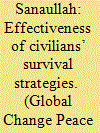

|
|
|
|
|
| Summary/Abstract |
Civilians deploy various strategies to survive violence in armed conflicts; literature, however, does not debate the relative effectiveness of such strategies. This article answers how certain strategies are valued and are employed frequently in comparison to others. Based on qualitative fieldwork in Swat Valley undertaken in 2016 to 2019, where Taliban insurgents fought against the State of Pakistan in 2007–09, the research finds that civilians deployed resistance, accommodation, resolution, readjustment and withdrawal to survive. It further finds that as violence intensifies, strategies of resistance and accommodation give way to strategies of readjustment and withdrawal.
|
|
|
|
|
|
|
|
|
|
|
|
|
|
|
|
| 10 |
ID:
106198
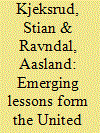

|
|
|
|
|
| Publication |
2011.
|
| Summary/Abstract |
Since December 2008, protection of civilians has been the primary task of the United Nations (UN) mission in the Democratic Republic of Congo (DRC). Guidance on how UN military units can contribute to the protection of civilians has been lacking, however. This has necessitated a bottom-up approach to protection of civilians in which the mission and its partners have developed a series of cross-cutting protection initiatives. The UN military plays a key role in many of them. Based on the findings of a 2010 field study conducted in the DRC, the paper discusses how UN military units can contribute to protection of civilians in three dimensions, namely civil-military cooperation, the use of intelligence, and the use of military force. The aim is to inform the preparation of military contributions to future missions mandated to protect civilians.
|
|
|
|
|
|
|
|
|
|
|
|
|
|
|
|
| 11 |
ID:
075204


|
|
|
|
|
| Publication |
London, Macmillan, 2006.
|
| Description |
xii, 544p.: ill., table, maps.Hbk
|
| Standard Number |
0333692853
|
|
|
|
|
|
|
|
|
|
|
|
Copies: C:1/I:0,R:0,Q:0
Circulation
| Accession# | Call# | Current Location | Status | Policy | Location |
| 051989 | 940.53/DAV 051989 | Main | On Shelf | General | |
|
|
|
|
| 12 |
ID:
184787
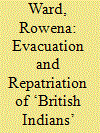

|
|
|
|
|
| Summary/Abstract |
In 1940, the Indian population resident in Japan was estimated at over 500. With the potential for war with Japan increasing, the British embassy in Tokyo advised locally resident British subjects to leave in October 1940 and again in February 1941. However, some, including a number of Indians, chose not to leave. This article considers the evacuation of the Indian population from Japan before December 1941 as well as those who departed as part of the wartime Anglo-Japanese Civilian Exchange. In doing so, it discusses the use of the SS Anhui to evacuate British subjects and also the lack of safe conduct for the City of Paris, which carried the Indian repatriates back to Bombay.
|
|
|
|
|
|
|
|
|
|
|
|
|
|
|
|
| 13 |
ID:
122059


|
|
|
| 14 |
ID:
155563
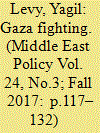

|
|
|
| 15 |
ID:
176375
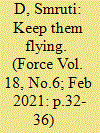

|
|
|
| 16 |
ID:
096859
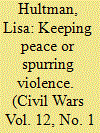

|
|
|
|
|
| Publication |
2010.
|
| Summary/Abstract |
Are peace operations effective in managing violence against civilians in civil wars? I examine the short-term effects of peace operations on the intensity of violence against the civilian population in internal conflicts. Missions are often sent to ongoing conflicts, where the warring parties have not yet managed to settle their dispute through the use of military means. I propose three mechanisms through which the presence of a third party may increase the parties' incentives to target civilians. A quantitative assessment of all intrastate armed conflicts, 1989-2006, shows that while the presence of a peace operation does not have a clear effect on government violence, it is associated with higher levels of violence by rebel groups. Only UN peace operations with an explicit mandate to protect civilians significantly reduce violence against civilians by rebels.
|
|
|
|
|
|
|
|
|
|
|
|
|
|
|
|
| 17 |
ID:
157745
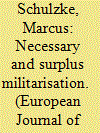

|
|
|
|
|
| Summary/Abstract |
Recent scholarship on militarisation suggests that Western democracies are threatened by military influence spreading into civilian domains. I contend that this research has identified problematic forms of militarisation, but that more careful attention should be given to different manifestations of this phenomenon. I borrow Herbert Marcuse’s distinction between necessary and surplus repression to show that militarisation can be excusable or excessive, depending on the context and its extent. Militarisation is potentially harmful and should be opposed when it is coercive or promotes militarism. By contrast, militarisation may be necessary if it is beneficial or ineliminable. A degree of militarisation may be desirable insofar as contact between civilians and soldiers promotes the spread of information, ensures that civilians have some influence on the military, and prevents members of the military from feeling detached and resentful. Some militarisation may also be indispensable for guarding against plausible threats or promoting social stability. Thus, militarisation should be treated as a process that has mixed costs and benefits depending on how it is enacted.
|
|
|
|
|
|
|
|
|
|
|
|
|
|
|
|
| 18 |
ID:
107837
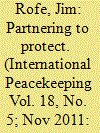

|
|
|
|
|
| Publication |
2011.
|
| Summary/Abstract |
Protection of civilians has been on the international agenda for more than ten years. In that time, many UN peace operations have received protection mandates but few have been successfully carried out. Protection requires all elements of a peace mission to have a common understanding of the relevant concepts, processes and desired outcomes. This requires partnerships between the various elements of the mission. Partnership between disparate groups is difficult at the best of times, and is exacerbated by the operational contexts of peace missions. Successful partnerships require extensive pre-mission preparation, in-mission coordination and post-mission evaluation. Participants have only just begun to address these issues at a basic level.
|
|
|
|
|
|
|
|
|
|
|
|
|
|
|
|
| 19 |
ID:
122767
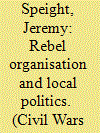

|
|
|
|
|
| Publication |
2013.
|
| Summary/Abstract |
Scholars have begun to show how variations in the organization of rebellion in war can impact outcomes related to the violence used against civilians, military effectiveness of armed groups and the post-conflict transitions. This article suggests that existing approaches in this literature overlook sub-group variations in relationships between national-level leaders of armed movements and local commanders. Exogenous factors that explain organizational variation and organizational effects are generally argued to be group wide. By focusing on the local level, I argue that many of the presumed downstream effects of variation in rebel organization can also contribute to the organizational choices leaders make for controlling local actors. This article demonstrates this argument through the case of Bouna in north-eastern Côte d'Ivoire, where a tax revolt against the local Forces Nouvelles (FN) administration, led by local Lobi youth, forced a restructuring in the relationship between Soro and the local FN commander, Morou Ouattara.
|
|
|
|
|
|
|
|
|
|
|
|
|
|
|
|
| 20 |
ID:
117825
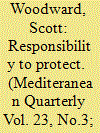

|
|
|
|
|
| Publication |
2012.
|
| Summary/Abstract |
This essay examines the theory of responsibility to protect, particularly as it clashes and melds with the concept of state sovereignty. The shift in focus takes center stage and highlights the progression of the premise that states everywhere are responsible for ensuring that mass atrocities against civilians do not occur, and culpable if they do.
|
|
|
|
|
|
|
|
|
|
|
|
|
|
|
|
|
|
|
|
|